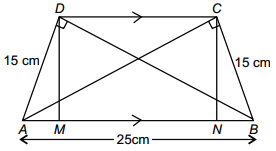(a) 192 cm2.
By Pythagoras' Theorem,
AC = \(\sqrt{AB^2-BC^2}\) and BD = \(\sqrt{AB^2-BC^2}\)

⇒ AC = BD = \(\sqrt{625-225}\) = \(\sqrt{400}\) = 2 cm (By prop.of isos. trap. AC = BD)
Now, Area of ΔDAB = \(\frac{1}{2}\) x AD x BD
Also, Area of ΔDAB = \(\frac{1}{2}\) x DM x AB
∴ AD x BD = DM x AB
⇒ DM = \(\frac{AD\times{BD}}{AB}\) = \(\frac{15\times20}{25}\) = 12 cm
Also, CN = DM = 12 cm
AM = \(\sqrt{AD^2-DM^2}\) = \(\sqrt{15^2-12^2}\) = \(\sqrt{225-144}\)
= \(\sqrt{81}\) = 9 cm
Also, BN = AM = 9 cm MN = AB – (AM + BN) = 25 – (9 + 9) = 25 – 18 = 7 cm
⇒ CD = MN = 7 cm
∴ Area of trapezium ABCD = \(\frac{1}{2}\) × DM × (AB + CD)
= \(\frac{1}{2}\) × 12 × (25 + 7) = \(\frac{1}{2}\) × 12 × 32 = 192 cm2.